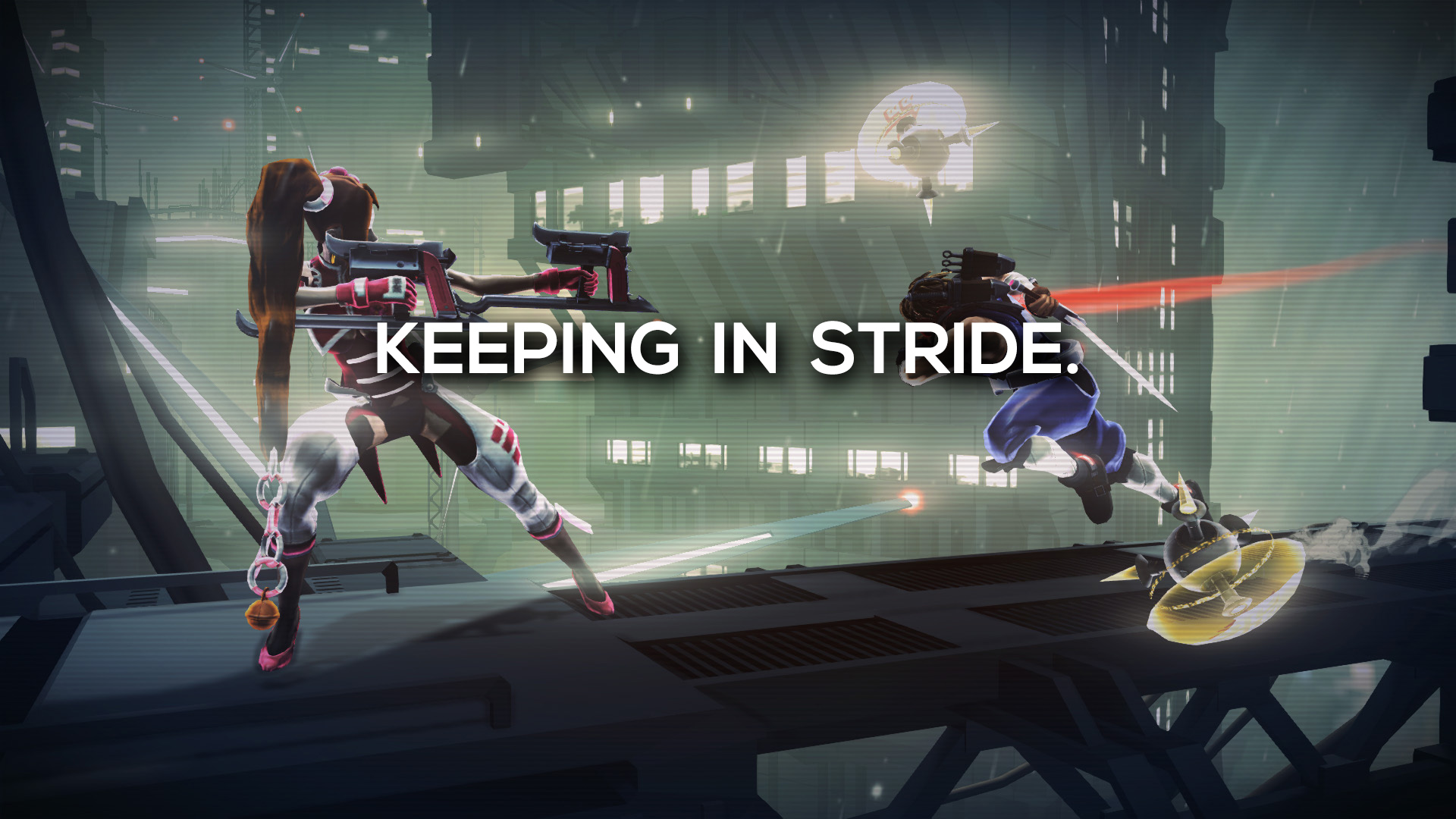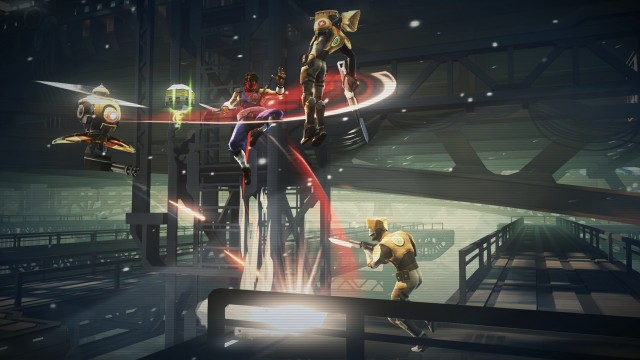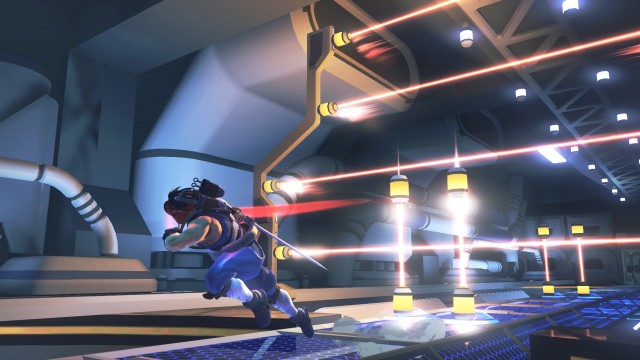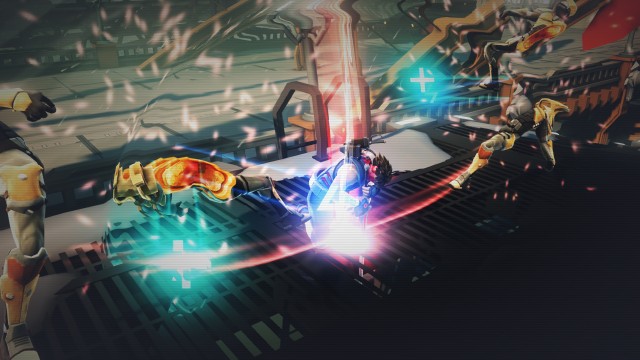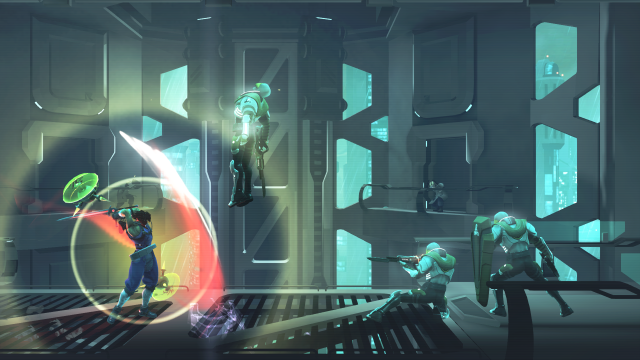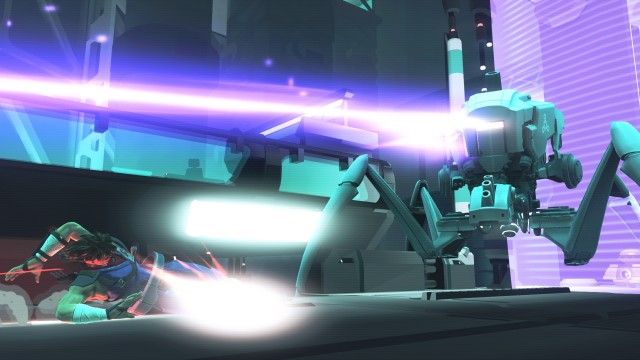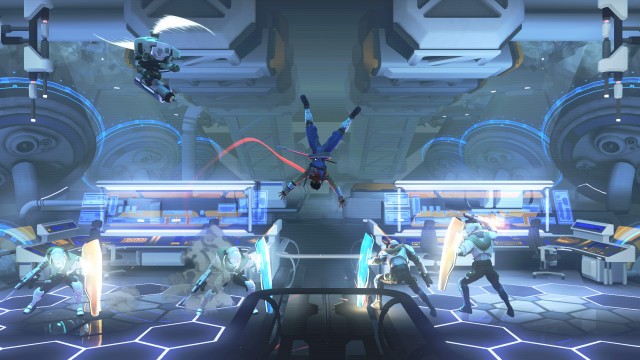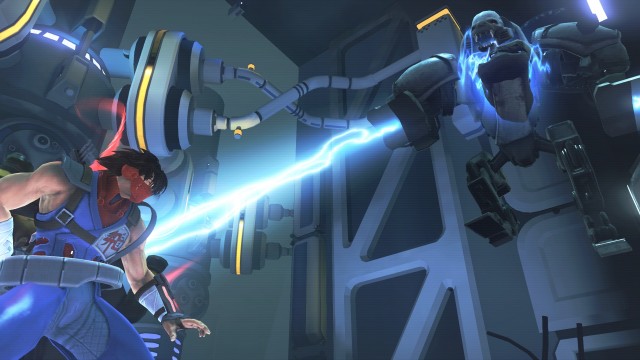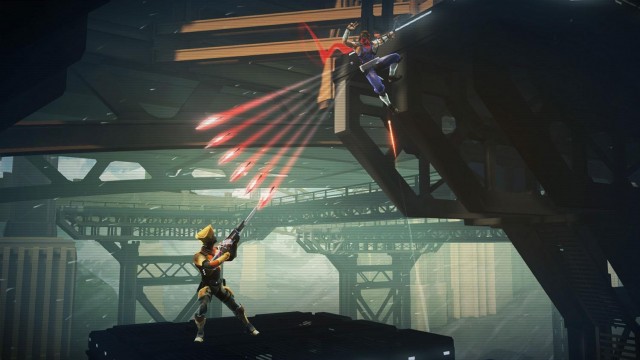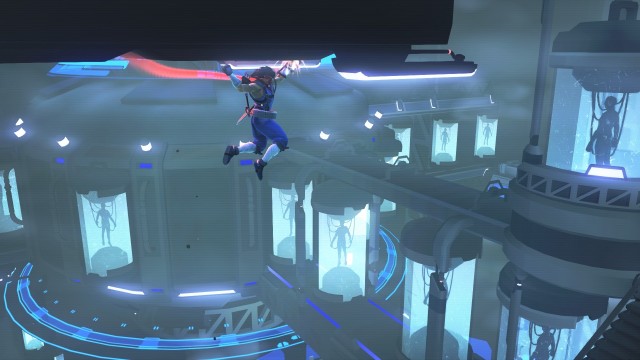Strider has finally returned!
With the Strider reboot’s original developer, Grin going bankrupt, Capcom had to find a contingency studio to bring back their action-packed, but disappointingly dormant ninja-themed game series. Fortunately, they chose well, as Strider comes to us from Double Helix Games, fresh off the success of revitalizing the Killer Instinct series for Microsoft and Rare on the Xbox One!
It’s actually kind of a shame that Double Helix has recently been acquired by Amazon, as they had just seemed to find their niche in the console gaming space. Like the new Killer Instinct, Strider is a fast, fun and satisfying revival of a series that has spent way too long in inactivity, beyond Strider protagonist, Strider Hiryu making regular apperances in the Marvel vs. Capcom series anyway, and having teasing cameos in various other Capcom games.
If you aren’t familiar with the cult classic that inspired this new game, Strider began as a well-received hack-and-slash arcade game by Capcom in 1989, one that received numerous ports to home computers, and arguably its most famous and beloved arcade-perfect rendition on the Sega Genesis. An offshoot of the same name was also released for the NES, though it was redone in an open-ended style of exploration, and told an entirely different story, with only the protagonist being shared with its arcade inspiration.
Strider’s 2014 reboot re-tells the plot and progression of the arcade game, with design elements and a few story nods to the NES game. This essentially makes it a cross between Ninja Gaiden and Super Metroid, unfolding against the villains and threats of the original arcade release, but having an open-ended environment to explore like the NES game.
As you can imagine then, Strider is one enormously entertaining action game, and the first powerhouse digital-exclusive game release of 2014! It’s ultimately a simple romp, and its relentless gameplay and high degree of challenge may frustrate some players, but if you have a taste for intense, retro-style action, this slash-’em-up offering should be high on your radar!
Strider is a game that has been translated beautifully to the modern HD era. The incredible flash and fluidity of the original arcade game has been re-captured and made better than ever, and Strider Hiryu himself stands out nicely from the environment, with his colourful movesets, bright visual palette and slick animations!
In fact, the only disappointing element to what’s otherwise a sharp-looking reboot is the environments, which are disappointingly bland, dank corridors for the most part. The odd time you’ll get to traipse around rooftops as blustering blizzards whoosh around you, or leap across flying carriers as you chase down an enormous battleship, but these standout environmental moments are sadly few and far between.
Considering that the arcade game had an amazing set of varied and vibrant level backdrops to leap and slash through, it’s disappointing that the reboot’s landscapes so often feel dark and grey. At least it’s not difficult to make out the flash and sparkle of your main character amidst these dreary environments, but more variation in their design really would have been appreciated.
Nonetheless, combat in Strider looks awesome, especially considering how incredibly responsive it is! In the next-gen builds especially, streaks and sparks will constantly surge and explode with every impact and every strike, frequently unfolding in dazzling displays of light and colour. Effects like flames, lasers, sparks, ice, and whatever else you and your enemies will throw at each other also look fantastic, creating combat that appears as intense as it is fun!
Inevitably however, one will ponder how Strider holds up visually between platforms. The game was released for both next-gen and last-gen consoles, as well as PC, and it definitely seems to be built with next-gen hardware in mind. On PS4, Xbox One and an optimal gaming PC, Strider animates at a slick 60fps without any slowdown, having only modest load times, and packing in both more detailed lighting contrast and better-rendered environmental and weapon effects, on top of predictably superior resolution overall. The more steady framerate also gives these versions smoother and especially quick, responsive controls, generally making them noticeably more satisfying to play.
Bear in mind however that the PS4 version seems to suffer from a few blurred textures. It’s not all that noticeable unless you’re running the PS4 and Xbox One versions side-by-side, but once you do see it, it’s difficult to stop noticing it. It’s probable that Double Helix’s work on Killer Instinct gave them a heightened understanding of the Xbox One architecture, leading to Strider being one of the first instances of having an Xbox One port that actually looks slightly superior to its PS4 counterpart.
The PC version scales well between settings meanwhile, and at its best, it pretty effortlessly stands with the especially colourful and sharp-looking Xbox One port. The system requirements aren’t too unreasonable (though you will need DirectX 11), but the PC version sometimes lacks the stability of its console cousins if you push your hardware. This leads to noticeably reduced game speed and control latency, and in a game like Strider, you don’t want that, at all!
Speaking of reduced speed, this is the biggest hit against the otherwise solid Xbox 360 and PS3 versions of the game. The reduced resolution on last-gen consoles leads to slightly less environmental definition and a few fuzzy or missing combat effects, but that’s hardly a dealbreaker. The real issue is in halving the framerate to 30fps in the last-gen builds, which noticeably hurts the appeal of Strider in contrast to its next-gen cousins.
The framerate reduction makes everything choppier and stiffer, creating less of a sense of fluidity in the gameplay overall. Not only that, but these last-gen ports, the PS3 version especially, suffer from slowdown, screen-tearing and other such visual blemishes more than they should. If you play on next-gen and then try to play on last-gen, you’ll feel like you’re missing a crucial element of smoothness and polish. Again, this isn’t a dealbreaker for people who don’t own next-gen consoles or a high-end gaming PC, but it makes the last-gen versions of Strider noticeably less fun and cool-looking than the next-gen versions.
Overall however, the graphics are well-done and do a good job of balancing retro 16-bit sensibilities with a modern HD art style. Needless to say, the Strider series has never looked better!
Strider contains a handful of remixed tracks from the NES game, done in a catchy techno style that isn’t badly-composed, but largely sits in the background.
For most of the game, you’ll instead be listening to the powerful strikes of Strider Hiryu’s weapon cypher, and yes, combat sounds as great as it looks in Strider! Even cutting apart your enemies at the start of the game sounds sharp and powerful, but as you track down upgrades and outfit Strider Hiryu with new weapons, combat only becomes more explosive and exciting!
It’s incredibly satisfying to feel the rapid freezing of an enemy with your ice cypher for example, then shatter it with an explosive dash that sets another enemy alight with a burst of rushing flame, before you unleash whirring magnetic blades that cut apart any hapless foes trying to flank you. When you get into the flow of combat, the incredible power and definition behind Strider’s sound effects really becomes apparent.
The power you’ll undeniably feel is another highlight as well. Strider is a difficult game, and you’ll die frequently, but even so, it makes you feel like a badass. Players will actively enjoy the rush of cutting, dashing and leaping through hordes of enemies, largely because the crisp sound of their defeats is so undeniably satisfying!
It’s a shame then that the voice acting is a lot more awkward and hammy. Strider Hiryu himself speaks with a slight Japanese accent, and is probably the best-voiced character in the game when you do hear him speak in certain cutscenes, but many of the other characters sometimes sound too detached or odd. Sometimes this works in creating an arcade-like Capcom atmosphere, complete with over-the-top villains and comically eccentric allies, but it would have worked better if the actors weren’t obviously struggling with a few wacky lines that couldn’t possibly be delivered efficiently, even in a game with arcade sensibilities!
All in all however, Strider sounds with a lot of might and fury, blending 16-bit excess with immersive HD-era polish to produce a potent mix of old and new in the audio!
Strider begins as many games of the 80’s and early 90’s did. Some bad people need killin’, and off you go!
Specifically, Strider, like the original arcade game that inspired it, takes place in the dystopian future of 2048, with the evil Grandmaster Meio enacting a brutal dictatorship on Eurasian metropolis, Kazakh City. The sole organization standing in his way are the Striders, a group of ninja assassins. Your player character, Strider Hiryu, the youngest-ever A-ranked Strider, is the one tasked with the assassination of Grandmaster Meio, and the game involves you infiltrating Kazakh City to carry out your task.
As you wander between the city’s environments, you’ll quickly notice similarities to the Metroid games. Various sections of Kazakh City are barred off until you track down new weapons and capabilities that can open specially locked doors (some of which appear early in the game and contain collectibles to find later!), and while a handy minimap continually points you to your current objective, you can choose to explore around at your leisure, opening new paths and finding goodies that net you concept art, story intel, health and energy upgrades, and bonus post-game challenges.
Combat on the other hand feels like a wonderful blend of Ninja Gaiden and Devil May Cry, on a 2D plane. While there’s a bit of latency on Xbox 360 and PS3, you can generally attack with Strider Hiryu’s katana-like cypher as fast as you can mash the button on PS4, Xbox One and optimal PC conditions. As you proceed on, you’ll also unlock the ability to dash, double jump, throw kunai projectiles, summon animal apparitions, and add elemental properties to your weapons, which gives you even more possibilities with which to take on Grandmaster Meio’s robot army.
As mentioned however, Strider is not an easy game! You’ll be quickly killed if you let yourself get overwhelmed by enemy attacks, putting both your button-mashing skills and reflexes to the test! Even then, you’ll suffer many defeats and boots to your last checkpoint (or save point), though fortunately, health is abundant outside of boss fights, and Strider Hiryu can usually easily make a quick getaway if things get too overwhelming, preventing Strider from being frustrating to the point of being unfair.
With that said however, some gameplay sections are a real doozy, harkening back to the questionably-balanced quarter-guzzling moments of the arcade game. With enough patience and persistence, you can prevail, but easily-frustrated players will want to throw their controllers through the screen during some of the game’s more chaotic sequences, which tend to pack in a combination of overpowered enemies and cheap tactics in an effort to frustrate you and make you sloppy. Victory is hard won in Strider’s most tense bouts, but it is so very sweet indeed when you do attain it!
Fortunately, the game’s large-scale, action-packed boss fights are outstanding! Some of the bosses are oddly easy once you figure out their patterns, but the many strong foes that stand against Strider Hiryu offer relentless battles and powerful attacks, demanding unwavering awareness and persistence to defeat them. Capcom games can usually be relied on for excellent boss battles, and it’s great to see that Strider is no exception, as its engaging, challenging bosses will be great fun for a skilled player to battle against!
The only thing that won’t really challenge you in Strider is the platforming, especially given your character’s incredible mobility, not to mention the fact that you can freely climb along walls and ceilings. Fortunately, some of the post-game challenges, and one tense racing section later in the game, will task players with quickly racing through an obstacle course, more effectively seeing how well you’ve mastered Strider’s incredible range of agility that’s awarded to a diligent player. The rest of the bonus challenges are simple horde battles against onslaughts of enemies, but they’re still fun, albeit less interesting.
Given the obvious Metroid inspiration in Strider, another predictable gripe that players will likely have to contend with is backtracking, especially if they intend to hunt down every collectible. Just playing through the game normally will occasionally force you to run back and forth between environments you’ve been through several times already to proceed on, but if you’re a completionist that wants every bonus and every achievement/trophy, you’ll spend quite a lot of time running from one end of the game map to the other, sometimes for little more than some paltry developer doodles.
Even if Strider is ultimately straightforward and can feasibly be beaten in anywhere from 4-6 hours despite this however, depending on your difficulty and how thorough you are with collectibles (one achievement/trophy is even awarded for beating the game in less than 4 hours on any difficulty), Strider is fun. It’s the kind of old school video gaming fun that’s too often been lost in our modern, cutting-edge console industry. It’s a tough, satisfying hack-and-slash diversion that doesn’t require a lot of thought, but offers white-knuckle action and perhaps some frustration, but also plenty of thrills throughout its duration!
Strider is, fittingly, the best game in the series since its arcade inspiration, and a strong revival for what should be a bigger Capcom franchise than it is! It’s best-suited to gamers who are actively seeking an action-packed, retro-style gaming challenge, but if that’s you, Strider is a perfect blend between old school 16-bit style mayhem and slick, modern HD polish.
The game is significantly more enjoyable on next-gen hardware, thanks to better-realized visuals and a smooth, consistent 60fps framerate, but even with some compromises to resolution and speed on Xbox 360 and PS3, Strider is action-packed and thrilling while it lasts, making it well worth the $14.99 asking price for those interested.
The Xbox One build is the most recommendable of the five, having the best visuals, stability and controls, though the PS4 version is still great if you don’t mind that handful of texture issues. Strider also handles pretty well on PC if your rig can handle it, but with that said, don’t even approach this game without a gamepad in that case! Strider is clearly built with consoles in mind, and trying to play it with a keyboard is just not feasible, so bear that in mind if you’re planning to pull the game off of Steam.
Regardless of your platform of choice however, Strider is yet another successful Capcom revival to stand with the equally impressive Bionic Commando Rearmed and Darkstalkers Resurrection from the previous console generation. If it’s raw, challenging action that you crave, Strider will engage and satisfy you in spades!
Now let’s just hope that the franchise doesn’t pull another disappearing act.

